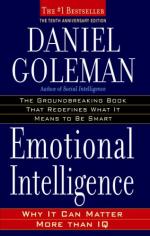
|
| Name: _________________________ | Period: ___________________ |
This test consists of 5 multiple choice questions, 5 short answer questions, and 10 short essay questions.
Multiple Choice Questions
1. John Mayer names three styles of handling one’s emotions. What is the second?
(a) The accepting.
(b) The engulfed.
(c) The justified.
(d) The self-aware.
2. What test did Walter Mischel devise in the 1960s?
(a) The Rutgers chicken experiment.
(b) The Harvard peanut experiment.
(c) The Stanford marshmallow experiment.
(d) The Columbia orange experiment.
3. Charisma combines four separate interpersonal intelligence components, according to what two psychologists discussed in Part Two: Chapter 8, “The Social Arts”?
(a) Ulf Dimberg and Peter Salovey.
(b) Ted Huston and Martin Seligman.
(c) Mihaly Csikszentmihalyi and T. Berry Brazelton.
(d) Thomas Hatch and Howard Gardner.
4. About how many years ago did mammals develop a neocortex?
(a) 100 million.
(b) 2,000.
(c) 20 million.
(d) 400,000.
5. During an emotional hijacking, emotions interfere with what, also known as the ability to take in and process information?
(a) Working memory.
(b) Verbal development.
(c) Intelligence Quotient.
(d) Somatic markers.
Short Answer Questions
1. Charisma combines four separate interpersonal intelligence components. What is the first?
2. Joseph LeDoux found that sensory signals from the eye or ear go to the thalamus and then to what?
3. Alexithymics may suffer from a disconnection between the limbic system and what?
4. Walter Mischel’s test in the 1960s measured what?
5. Psychologists Peter Salovey and John Mayer define emotional intelligence into five categories. What is the first category?
Short Essay Questions
1. What did Daniel Stern term the process of reinforcing empathy in children? How is this defined in Part Two: Chapter 7, “The Roots of Empathy”?
2. Where in the brain is the limbic system located? What purpose does this section of the brain serve?
3. What test did Walter Mischel devise in the 1960s? How is the test described in Part Two: Chapter 6, “The Master Aptitude”?
4. How does researcher Paul Ekman describe his three “display rules” for emotions in Part Two: Chapter 8, “The Social Arts”?
5. How is alexithymia defined in Part Two: Chapter 4, “Know Thyself”? Who coined this term?
6. What tests do children take in Project Spectrum?
7. How is the amygdala capable of surpassing the neocortex in moments of emotional hijacking?
8. What are the impacts of extreme emotions, according to the author in Part Two: Chapter 5, “Passion's Slaves”? What is the opposite called?
9. What did Ulf Dimberg discover about expressions of emotion, according to the author in Part Two: Chapter 8, “The Social Arts”?
10. What biological explanation is given as a possible cause for alexithymia in Part Two: Chapter 4, “Know Thyself”?
|
This section contains 791 words (approx. 3 pages at 300 words per page) |

|




